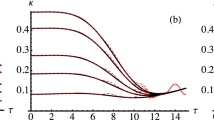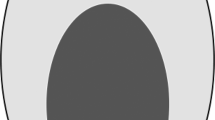Abstract
Almost all modern communication systems rely on electromagnetic fields. The additive white Gaussian noise (AWGN) channel is often a good approximate description of such a system, and its information-carrying capacity is given by a simple formula. The quantum analogue of AWGN channels, the bosonic Gaussian noise channel, accurately describes many quantum optical communication systems of interest. Estimating its capacity is significantly more difficult; although some simple coding strategies are known, whether or not more sophisticated techniques could dramatically improve communication rates has been unknown. Here, we present strong new upper bounds for the classical capacity of bosonic Gaussian noise channels. These results imply that known coding techniques are typically close to optimal. Our main technical tool is an entropy power inequality bounding the entropy produced as two quantum signals combine at a beamsplitter. Its proof relies on a quantum diffusion process which smooths arbitrary states towards Gaussians.
This is a preview of subscription content, access via your institution
Access options
Subscribe to this journal
Receive 12 print issues and online access
$209.00 per year
only $17.42 per issue
Buy this article
- Purchase on Springer Link
- Instant access to full article PDF
Prices may be subject to local taxes which are calculated during checkout




Similar content being viewed by others
Change history
24 January 2013
In the version of this Article originally published, the author affiliations were incorrect and should have read: 1IBM TJ Watson Research Center, 1101 Kitchawan Road, Yorktown Heights, New York 10598, USA, 2Institute for Quantum Computing and Department of Applied Mathematics, University of Waterloo, ON, Canada, N2L3G1. This has now been corrected in the HTML and PDF versions of the Article.
References
Shannon, C. E. A mathematical theory of communication. Bell Syst. Tech. J. 27, 379–423, 623–656 (1948).
Pierce, J. The early days of information theory. IEEE Trans. Inf. Theory 19, 3–8 (1973).
Schumacher, B. & Westmoreland, M. D. Sending classical information via noisy quantum channels. Phys. Rev. A 56, 131–138 (1997).
Holevo, A. The capacity of the quantum channel with general signal states. IEEE Trans. Inf. Theory 44, 269–273 (1998).
Hastings, M. B. Superadditivity of communication capacity using entangled inputs. Nature Phys. 5, 255–257 (2009).
Holevo, A. S. & Werner, R. F. Evaluating capacities of bosonic Gaussian channels. Phys. Rev. A 63, 032312 (2001).
Eisert, J. & Wolf, M. M. Gaussian quantum channels. Preprint at http://arxiv.org/abs/quant-ph/0505151 (2005).
Giovannetti, V. et al. Classical capacity of the lossy bosonic channel: the exact solution. Phys. Rev. Lett. 92, 027902 (2004).
Stam, A. Some inequalities satisfied by the quantities of information of Fisher and Shannon. Inform. Control 2, 101–112 (1959).
Blachman, N. The convolution inequality for entropy powers. IEEE Trans. Inf. Theory 11, 267–271 (1965).
Verdu, S. & Guo, D. A simple proof of the entropy-power inequality. IEEE Trans. Inf. Theory 52, 2165–2166 (2006).
Rioul, O. Information theoretic proofs of entropy power inequalities. IEEE Trans. Inf. Theory 57, 33–55 (2011).
Bergmans, P. A simple converse for broadcast channels with additive white Gaussian noise (corresp.). IEEE Trans. Inf. Theory 20, 279–280 (1974).
Leung-Yan-Cheong, S. & Hellman, M. The Gaussian wire-tap channel. IEEE Trans. Inf. Theory 24, 451–456 (1978).
Dembo, A., Cover, T. & Thomas, J. Information theoretic inequalities. IEEE Trans. Inf. Theory 37, 1501–1518 (1991).
Wolf, M. M., Giedke, G. & Cirac, J. I. Extremality of Gaussian quantum states. Phys. Rev. Lett. 96, 080502 (2006).
Giovannetti, V., Holevo, A., Lloyd, S. & Maccone, L. Generalized minimal output entropy conjecture for one-mode Gaussian channels: definitions and some exact results. J. Phys. A 43, 032315 (2010).
Barron, A. R. Monotonic Central Limit Theorem for Densities, Department of Statistics Technical Report 50 (Stanford University, 1984).
Wehrl, A. General properties of entropy. Rev. Mod. Phys. 50, 221–260 (1978).
Smith, G. & Smolin, J. in Information Theory Workshop 368–372 (Porto, 2008).
King, C. & Ruskai, M. Minimal entropy of states emerging from noisy quantum channels. IEEE Trans. Inf. Theory 47, 192–209 (2001).
Shor, P. Equivalence of additivity questions in quantum information theory. Commun. Math. Phys. 246, 453–472 (2004).
Giovannetti, V., Guha, S., Lloyd, S., Maccone, L. & Shapiro, J. H. Minimum output entropy of bosonic channels: a conjecture. Phys. Rev. A 70, 415305 (2004).
Petz, D. Covariance and Fisher information in quantum mechanics. J. Phys. A 35, 929–939 (2002).
König, R. & Smith, G. The entropy power inequality for quantum systems. Preprint at http://www.arxiv.org/abs/1205.3409 (2012).
Hall, M. J. W. Quantum properties of classical Fisher information. Phys. Rev. A 62, 012107 (2000).
Zamir, R. A proof of the fisher information inequality via a data processing argument. IEEE Trans. Inf. Theory 44, 1246–1250 (1998).
Guha, S., Shapiro, J. & Erkmen, B. in Proceedings of Information Theory 2008, IEEE International Symposium on Information Theory, 91–95 (2008).
Serafini, A., Eisert, J. & Wolf, M. M. Multiplicativity of maximal output purities of Gaussian channels under Gaussian inputs. Phys. Rev. A 71, 012320 (2005).
Smith, G., Smolin, J. A. & Yard, J. Quantum communication with Gaussian channels of zero quantum capacity. Nature Photon. 5, 624–627 (2011).
Costa, M. A new entropy power inequality. IEEE Trans. Inf. Theory 31, 751–760 (1985).
Yard, J., Hayden, P. & Devetak, I. Quantum broadcast channels. IEEE Trans. Inf. Theory 57, 7147–7162 (2011).
Hudson, R. L. A quantum-mechanical central limit theorem for anti-commuting observables. J. Appl. Probab. 10, 502–509 (1973).
Barron, A. Entropy and the Central Limit Theorem. Ann. Probab. 14, 336–342 (1986).
Acknowledgements
The authors thank C. Bennett, J. Gambetta and J. Smolin for helpful comments and S. Guha for discussions. Both authors were supported by the Defense Advance Research Projects Agency Quantum Entanglement Science and Technology programme (contract no. HR0011-09-C-0047).
Author information
Authors and Affiliations
Contributions
R.K. and G.S. designed and carried out the research and wrote the paper.
Corresponding authors
Ethics declarations
Competing interests
The authors declare no competing financial interests.
Supplementary information
Supplementary information
Supplementary information (PDF 539 kb)
Rights and permissions
About this article
Cite this article
König, R., Smith, G. Limits on classical communication from quantum entropy power inequalities. Nature Photon 7, 142–146 (2013). https://doi.org/10.1038/nphoton.2012.342
Received:
Accepted:
Published:
Issue Date:
DOI: https://doi.org/10.1038/nphoton.2012.342
This article is cited by
-
Weighted p-Rényi Entropy Power Inequality: Information Theory to Quantum Shannon Theory
International Journal of Theoretical Physics (2023)
-
Two-particle indistinguishability and identification of boson and fermion species: a Fisher information approach
Quantum Information Processing (2019)
-
Is there an optimal basis to maximise optical information transfer?
Scientific Reports (2016)
-
A Solution of Gaussian Optimizer Conjecture for Quantum Channels
Communications in Mathematical Physics (2015)
-
Ultimate classical communication rates of quantum optical channels
Nature Photonics (2014)



